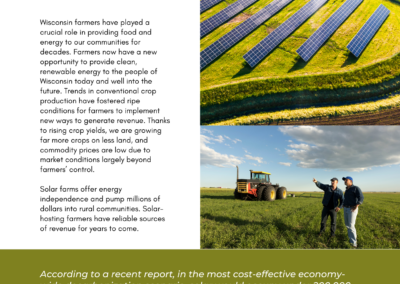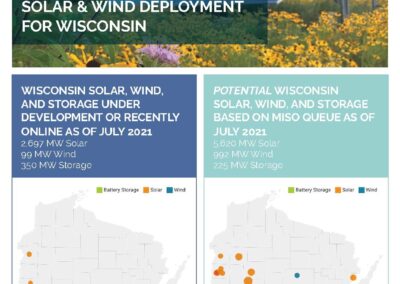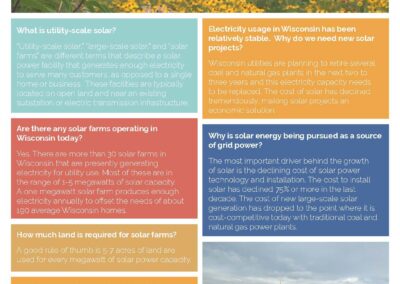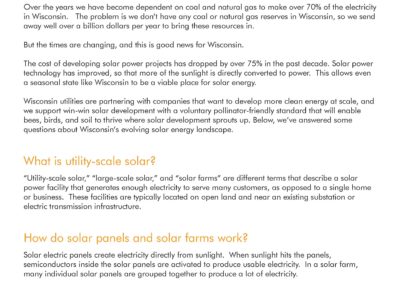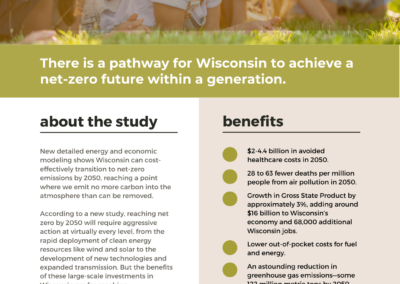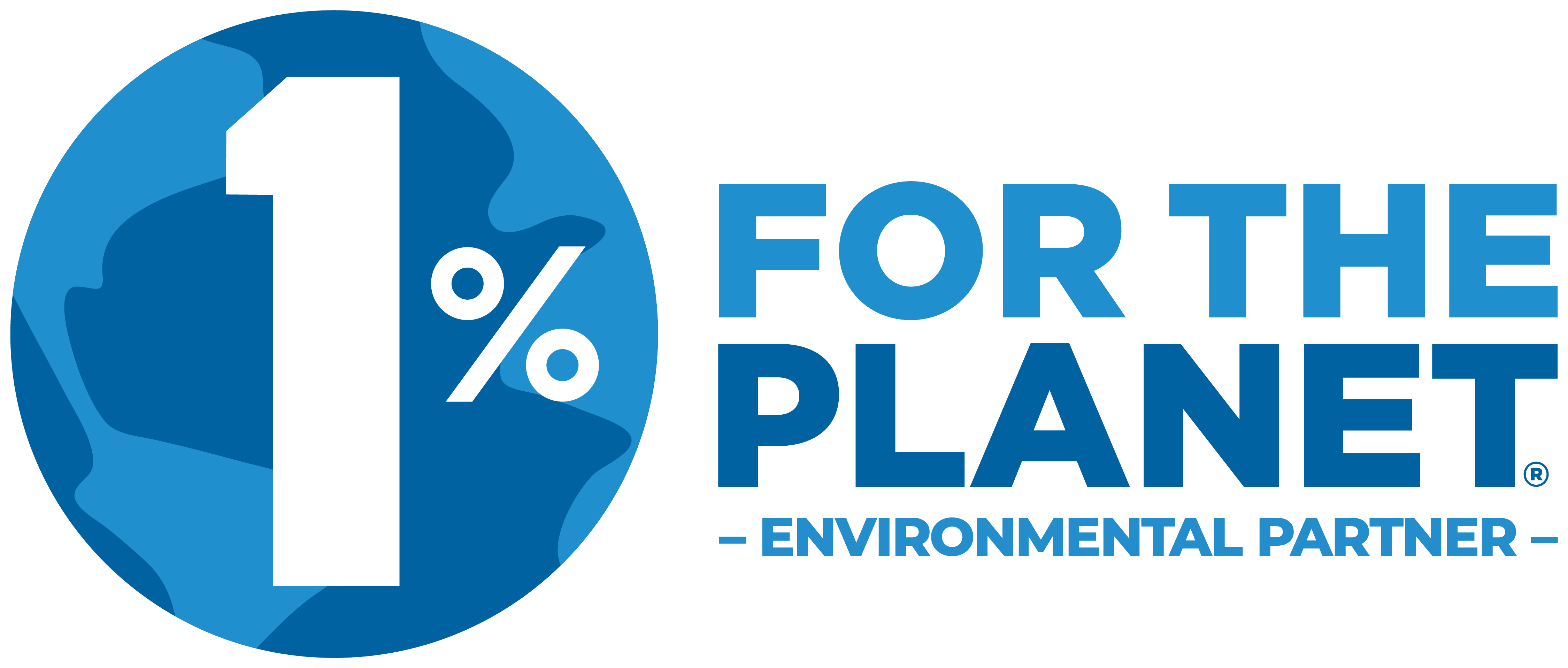Over the years we have become dependent on coal and natural gas to make over 70% of the electricity in Wisconsin. It’s worth noting that we don’t have any coal or natural gas reserves in Wisconsin, so we send away well over a billion dollars per year to bring these resources in.
But the times are changing, and this is good news for Wisconsin.
The cost of developing solar power projects has dropped by over 75% in the past decade. Solar power technology has improved, so that more of the sunlight is directly converted to power. This allows even a northern state like Wisconsin to be a viable place for generating solar power.
Wisconsin utilities are partnering with companies that want to develop more clean energy at scale. With solar development comes an opportunity to restore soil health and enhance ecological services which will enable the land to be returned to agricultural purposes at the end of the solar project’s operating life. Furthermore, developers and landowners are exploring ways of integrating crops and livestock with a solar project— a concept called agrivoltaics. Below, we’ve answered some questions about Wisconsin’s evolving solar energy landscape.
What is utility-scale solar?
“Utility-scale solar,” “large-scale solar,” and “solar projects” are different terms that describe a solar power facility that generates enough electricity to serve many customers, as opposed to a single home or business. These facilities are typically located on open land and near an existing substation or electric transmission infrastructure.
How do solar panels and solar projects work?
Solar electric panels create electricity directly from sunlight. When sunlight hits the panels, semiconductors inside the solar panels are activated to produce usable electricity. In a solar project, many individual solar panels are grouped together to produce a large amount of electricity that feeds into transmission lines.
In most cases, panels are mounted on “single-axis tracking systems.” Solar panels are attached to horizontal poles which run north to south. Throughout the day the panels rotate from east to west to follow the sun.
The project equipment includes solar panels, racking, cables, inverters, transformers, and a power line or substation to deliver the power to the electric transmission grid.
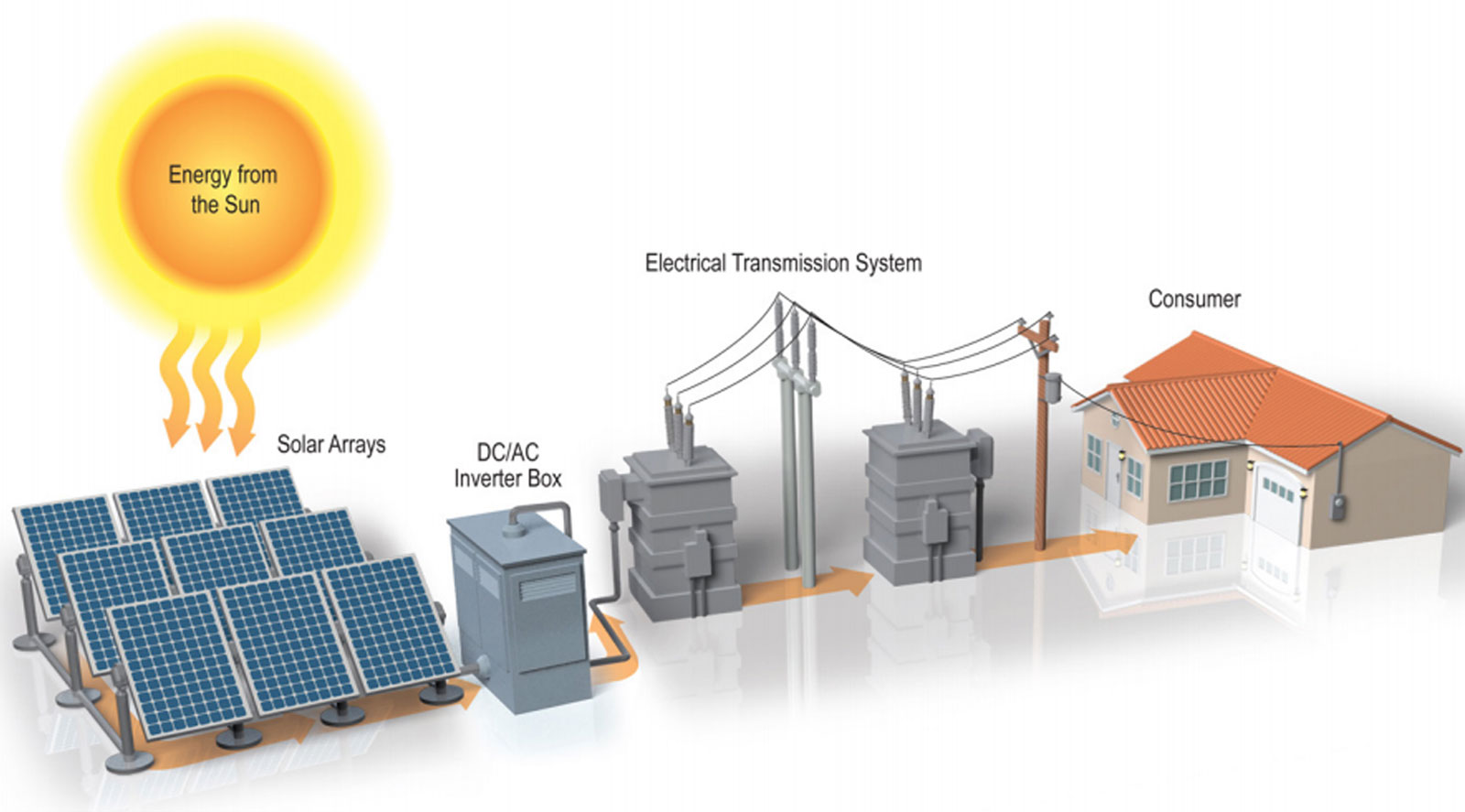
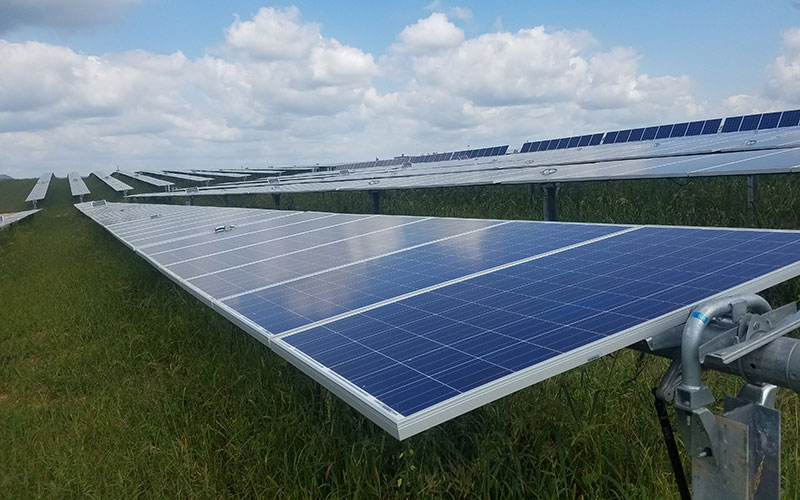
Are there any solar projects operating in Wisconsin today?
Yes. There are more than 20 solar farms in Wisconsin that are presently generating electricity for utility use. Many of these are in the range of 1-5 megawatts of solar capacity. A one megawatt solar farm produces enough electricity annually to offset the needs of about 190 average Wisconsin homes.
Who are the developers of these solar projects?
Most solar projects in Wisconsin are developed by private companies that have developed renewable energy facilities in many other states. Among developers active in Wisconsin are: Invenergy, Savion, Tyr Energy Development, National Grid, and Samsung. Alone among Wisconsin’s electric utilities Alliant Energy is developing a solar portfolio consisting of a dozen projects totaling more than 1 gigawatt (1000 megawatts).
Who uses the energy from these solar developments?
Wisconsin electric customers do! Thus far, all solar projects built or proposed in Wisconsin are owned by, or sell their electricity to, Wisconsin electric providers. Among the providers purchasing solar energy and using it to serve their many customers are Dairyland Power Cooperative, Madison Gas and Electric, We Energies, Wisconsin Public Service, Xcel Energy, Alliant, and WPPI Energy.
Are there new solar projects in the works?
Yes. Several projects have been announced or have entered a permitting process.
Why are solar projects being pursued as a source of grid power?
The most important drivers propelling solar power are its low cost relative to other resources and its relatively short development time. The cost of new large-scale solar generation has dropped to the point where it is cost-competitive today with existing fossil fuel power plants.
How much land is required for solar projects?
Typically, one megawatt of solar power capacity will cover approximately seven acres. In the normal course of project development, a solar developer will establish leases for additional land to provide more flexibility in laying out the arrays, routing interconnection corridors, and meeting state requirements for alternative siting options.
What government agencies are involved in approving these types of projects?
In the vast majority of solar power plants approved by the PSC, developers and affected local governments negotiated and entered into Joint Development Agreements (JDAs). The terms are binding on the parties. Examples of JDAs are available at the appropriate docket board on the PSC’s website (e.g., Portage Solar, 9810-CE-100).
RENEW Wisconsin believes solar farms should remain zoned “agricultural” where applicable, with a conditional use permit to allow for solar energy generation. This is for two reasons. First, to increase the chances that the land will go back into agriculture after the solar project’s lifetime. Second, plantings under the arrays can be designed to support agricultural purposes such as supporting pollinators, rebuilding the soil, and provide similar functions as land in the federal Conservation Reserve Program (CRP).
Solar farms sized 100 megawatts and larger also must gain approval from the Public Service Commission of Wisconsin. This process is called a Certificate for Public Convenience and Necessity, or CPCN.
There are opportunities for public comment at the township, county, and state levels. These projects are reviewed by many government agencies to foster low-impact development and encourage community engagement.
Electricity usage in Wisconsin has been relatively stable. Why are new solar projects needed?
Wisconsin utilities have started retiring their older coal and natural gas plants and will accelerate plant closures over the next two to three years. That generating capacity needs to be replaced to maintain system reliability. Notwithstanding recent price increases, solar remains the most cost-effective replacement option for utilities and will become more so with the availability of new incentives included in the recently adopted Inflation Reduction Act (IRA). Assuming no major changes in pricing, the combination of utility-scale solar with battery energy storage systems (BESS) shapes up to generate considerable savings to utility customers without any disruptions to system operations.
How does battery energy storage fit into Wisconsin’s electricity landscape?
Using lithium-ion technology, battery energy storage systems (BESS) have advanced to the point where they can store large amounts of electricity for up to four hours. Over the normal course of operation, solar projects generate their maximum output in the middle of the day. BESS systems store some of that electricity for later use. Holding that generation in reserve enables solar plant operators to discharge that stored electricity later in the afternoon and early evening hours when demand for electricity usually peaks.
How can solar projects benefit local governments?
In Wisconsin, owners of solar farms greater than 50 megawatts pay annually into a utility aid fund which is shared with the local governments where the solar farm is located. Under the revenue sharing formula currently in place, a qualifying solar farm will contribute $2,333 per megawatt (MW) per year to the county and $1,667 per MW to the township(s) hosting the project, for a total of $4,000 per MW per year.
For example, a 100 MW solar farm would provide approximately $233,000 annually to the host county and approximately $167,000 annually to the host township(s). Over the first 25 years of such a project’s operating life, over $10 million would be provided to the local governments where the project is located.
For projects 50 megawatts are larger, the private land leased to a solar farm becomes exempt from local property taxes. Although this land will no longer pay property taxes, the net gain to the local governments is estimated to be at least 10 times higher than the lost property taxes.
For example, a 300 megawatt project being pursued in Wisconsin has found that the property taxes currently paid to local governments amount to less than $100,000 for the land that would be transferred into a solar lease. In contrast, $1,200,000 will be paid annually to the local governments if the solar project is approved.
How can solar projects benefit community residents?
With a fresh flow of revenue generated from solar farms, local governments will have the option of either allocating those dollars toward essential public services, reducing property tax rates broadly, or both. A few Wisconsin jurisdictions that host renewable energy projects have used shared revenues to supplement their road maintenance and repair budgets, while others have augmented police and fire service through vehicle and equipment purchases. Utility local aid revenue has no strings attached to it, thereby enabling local elected officials to use their discretion to decide how the revenue can best serve their communities.
Can hosting solar panels help agricultural land?
Yes. The land that supports solar arrays can be revegetated with a range of low-lying, deep-rooted plants, grasses, and flowers that can rebuild the soil. In addition, these plantings can support honey bees, butterflies, hummingbirds, and other pollinators whose populations are facing threats.
Is the conversion of agricultural land to solar generation permanent?
No. Modern large-scale solar installations use steel posts that are driven or screwed into the ground, but do not use concrete pilings. This means that the land can very easily be converted back to farmland after the life of the solar project. The life of the project is estimated to be 25-40 years. Upon the conclusion of the lease and the decommissioning of the project, the landowner is able to resume traditional agricultural operations on the land.
Notwithstanding the growth of farm-based solar generation across the United States, the total amount of agricultural land being used for solar energy is small compared with the permanent conversion of agricultural land to residential housing and commercial development.
In fact, Wisconsin could produce about 50% of our annual electricity needs through the use of solar panels on only 125,000 acres of land. For comparison, according to the USDA, as of 2021 the total land in farms for Wisconsin was approximately 14,300,000 acres.
Can solar panels withstand strong winds?
Testing by solar manufacturers includes a certification that the panels can withstand winds of up to 140 miles-per-hour, the equivalent of a Category 4 hurricane. In real-world performance, there are reports that nearly all solar panels located in areas hit by Superstorm Sandy (2012), Hurricane Michael (2016), and Hurricane Irma (2017), survived the high winds with few panels damaged beyond functionality. Any other losses were due to the destruction of an entire roof or structure.
Are solar panels a safe technology?
Yes. Solar panels are safe to touch, attach to your home, and install in your neighborhood or town.
Panels are primarily made of glass, aluminum, copper, and other common materials. Solar projects also utilize steel racks to position panels, electrical cable and inverters and electric transformers to deliver power to the grid. All of this equipment is safe and contains the same materials that are found in household appliances. There are trace amounts of chemicals in solar panels that enable them to produce electricity. These compounds are completely sealed within the glass and coatings of the panels.
After their useful life, solar panels and equipment are easy to disassemble and recycle. Solar facilities are constantly monitored, and the owners have a business interest in keeping them well-maintained and operating properly. Solar plants are designed to withstand severe weather, and panels are built to last for up to 40 years. If solar panels are damaged, they can be quickly replaced with new ones.
(Credit for this Q&A: Illinois Solar Energy Association)
What is it like living next to a solar project?
Solar farms are quiet neighbors. They are a very low-impact development within communities.
Unlike using natural gas or coal to generate power, they do not combust anything and thus have no pollution. They do not create any odors or output any chemicals.
Solar farms use no water for their operation. This is also in stark contrast to using coal or natural gas to make electricity.
The only audible noise is from cooling fans within equipment (inverters and transformers) that move the electric power to the grid, and those only operate when the sun is shining and power is being produced. After the sun goes down, there is no audible noise from the solar equipment.
Native vegetation under the arrays can improve water quality and reduce runoff in the area.
Will there be stray voltage from a solar project?
No. The collection and transmission lines used in these modern solar farm effectively prevent stray voltage. These lines are significantly different than what might be seen in local distribution systems or low-voltage wiring in sheds, barns, and dairy facilities.
Will glare from the solar panels be a problem?
No, this is actually a common misconception about solar PV modules. Solar modules are made to absorb sunlight, not to reflect it. Solar modules are flat, have a relatively smooth surface, and are covered with anti-reflective coatings. Modern PV modules reflect as little as two percent of incoming sunlight, about the same as water and less than soil or even wood shingles.
What happens if there is snow on the solar panels?
In larger solar farms, the solar panels rotate throughout the day. When they are tilted, snow will slide off on its own. If some portion of the panels are covered in snow, the remaining portion can still generate power and, in doing so, will generate some heat that will encourage melting of the rest of the snow.
How do solar panels produce power when it’s not sunny?
At night the solar panels go into standby mode and do not produce any energy. However, even on cloudy days the panels are producing power.
Can some of the solar power be stored in batteries to use at night?
A “Battery Energy Storage System” (BESS) is a potential accessory to a solar project. Battery storage could provide many benefits, including:
- Allowing the solar energy to be stored and released at different parts of the day
- “Smooth” the output of solar electricity on partly cloudy days
- Help maintain the proper frequency of electricity on the grid
- Potentially could be used for backup emergency power
How many jobs will be created to construct an operate a solar project?
As an example, a 300 MW project might create 500 new local jobs while in construction, and 5 operations and maintenance jobs once it is operational.
Do solar projects protect the wildlife in the area?
Solar PV projects by themselves do not present a significant risk to wildlife. When native meadow ground cover is used, the project will create new habitat for pollinating insects and birds, as well as improve water quality for local aquatic species. Projects are also required to install fencing, which keeps wildlife out and reduces risk to animals in the area.
Are the solar panels or any of the other components made in Wisconsin?
Although we do not have any solar panel manufacturing in Wisconsin, many of the parts needed to build and operate solar farms are indeed made in Wisconsin. See a list of products manufactured in Wisconsin for large solar projects.

